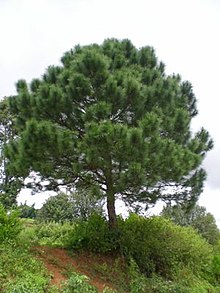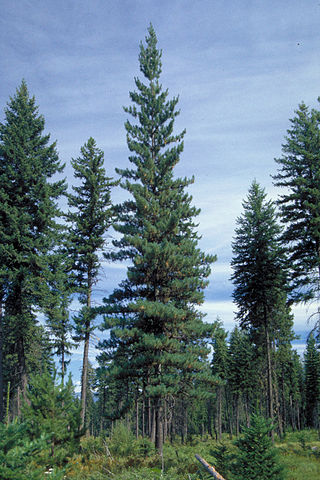
Western white pine, also called silver pine and California mountain pine, is a species of pine in the family Pinaceae. It occurs in mountain ranges of northwestern North America and is the state tree of Idaho.
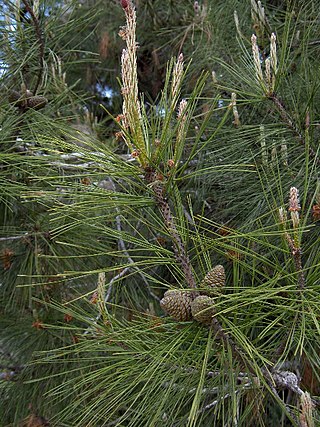
Pinus brutia, commonly known as the Turkish pine and Calabrian pine, is a species of pine native to the eastern Mediterranean region. The bulk of its range is in Turkey, but certain varieties are naturalized as far east as Afghanistan. It is also known as East Mediterranean pine, Afghan pine, and Brutia pine. The name "Calabrian pine" comes from an introduced grove in the Calabria region of southern Italy; historically this region was called Bruttium, which is likely where the specific epithet "brutia" comes from. Pinus brutia bears many similarities with other, closely related species such as Pinus halepensis and Pinus canariensis. Turkish pine forms a species complex with the former.

Pinus cembra, also known as Swiss pine, Swiss stone pine, Arolla pine, Austrian stone pine, or just stone pine, is a species of pine tree in the subgenus Strobus.

Pinus halepensis, commonly known as the Aleppo pine, also known as the Jerusalem pine, is a pine native to the Mediterranean region.

Pinus merkusii, the Merkus pine or Sumatran pine, is a pine native to the Malesia region of southeast Asia, and the only one that occurs naturally south of the equator.

Pinus cembroides, also known as pinyon pine, Mexican pinyon, Mexican nut pine, and Mexican stone pine, is a pine in the pinyon pine group, native to western North America. It grows in areas with low levels of rainfall and its range extends southwards from Arizona, Texas and New Mexico in the United States into Mexico. It typically grows at altitudes between 1,600 and 2,400 metres. It is a small pine growing to about 20 m (66 ft) with a trunk diameter of up to 50 cm (20 in). The seeds are large and form part of the diet of the Mexican jay and Abert's squirrel. They are also collected for human consumption, being the most widely used pine nut in Mexico. This is a common pine with a wide range and the International Union for Conservation of Nature has rated its conservation status as being of "least concern".

Pinus orizabensis, the Orizaba pinyon, is a pine in the pinyon pine group, endemic to central Mexico. It is considered also as a sub-species of Pinus cembroides which is classified as Pinus cembroides subsp. orizabensis D.K.Bailey. It has larger seeds than the type.

Pinus culminicola, commonly known as Potosí pinyon or Potosí Piñón, is a pine in the pinyon pine group, native and endemic to northeast Mexico. The range is highly localised, confined to a small area of high summits in the northern Sierra Madre Oriental in Coahuila and Nuevo León, and only abundant on the highest peak, Cerro Potosí. It occurs at very high altitudes, from 3000–3700 m, in cool, moist subalpine climate conditions.

Pinus remota, commonly known as the Texas pinyon or papershell pinyon, is a pine in the pinyon pine group, native to southwestern Texas and northeastern Mexico. It can be distinguished from other pinyon species by its thin-walled seeds, which made it especially attractive as a food to Indians and Mexicans living where it grew. Spanish explorer Cabeza de Vaca noted that the papershell pinon was an important food for the Indians in 1536.
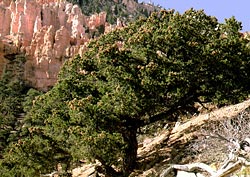
Pinus edulis, the Colorado pinyon, two-needle piñon, pinyon pine, or simply piñon, is a pine in the pinyon pine group native to the Southwestern United States, used for its edible pine nuts.
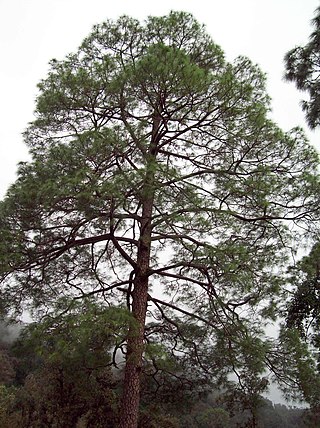
Pinus roxburghii, commonly known as chir pine or longleaf Indian pine, is a species of pine tree native to the Himalayas. It was named after William Roxburgh.

Pinus monophylla, the single-leaf pinyon, is a pine in the pinyon pine group, native to North America. The range is in southernmost Idaho, western Utah, Arizona, southwest New Mexico, Nevada, eastern and southern California and northern Baja California.

Pinus quadrifolia, the Parry pinyon, is a pine in the pinyon pine group native to southernmost California in the United States and northern Baja California in Mexico, from 33° 30' N south to 30° 30' N. The Parry pinyon has a lifespan of around 200 to 500 years. It is usually found in rocky areas that often have thin soil. It occurs at moderate altitudes from 1,300 metres (4,300 ft) to 1,800 metres (5,900 ft), rarely as low as 1,200 metres (3,900 ft) and as high as 2,500 metres (8,200 ft). It is scarce and often scattered in this region, forming open woodlands, usually mixed with junipers. Other common names include nut pine and fourleaf pinyon pine.

Pinus aristata, the Rocky Mountain bristlecone pine, is a long-living species of bristlecone pine tree native to the United States. It appears in the Rocky Mountains in Colorado and northern New Mexico, with isolated populations in the San Francisco Peaks in Arizona and the Kaibab National Forest north of the Grand Canyon. It is usually found at very high altitudes, from 7,000–13,000 feet (2,100–4,000 m), in cold, dry subalpine climate conditions, often at the tree line, although it also forms extensive closed-canopy stands at somewhat lower elevations.

Pinus hwangshanensis, or Huangshan pine, is a species of pine endemic to the mountains of eastern China; it is named after the Huangshan Mountains in Anhui, from where it was first described.
Pinus squamata, the Qiaojia pine or southern lacebark pine, is a critically endangered pine native to a single locality consisting of about 20 trees in Qiaojia County, northeast Yunnan, China, at about 2,200 m (7,200 ft) elevation.

Pinus hartwegii, Hartweg's pine, the Mexican mountain pine, or pino de las alturas, is a pine native to the mountains of Mexico and Central America east to Honduras. It is named after Karl Theodor Hartweg, who described it in 1838.
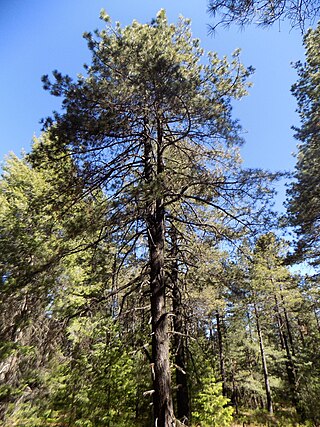
Pinus durangensis, the Durango pine, is a pine tree species endemic to the Sierra Madre Occidental mountain range of north-western Mexico.

Pinus maximartinezii, called Martinez pinyon, big-cone pinyon or maxipiñon, is a pine in the pinyon pine group, native to west-central Mexico.

Pinus massoniana is a species of pine, native to Taiwan, a wide area of central and southern China, and northern Vietnam.
